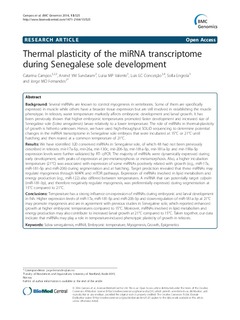Thermal plasticity of the miRNA transcriptome during Senegalese sole development
Campos, Catarina; Sundaram, Arvind; Valente, Luisa M.P.; Conceicao, Luis E.C.; Engrola, Sofia; Fernandes, Jorge M.O.
Journal article, Peer reviewed

Åpne
Permanent lenke
http://hdl.handle.net/11250/224521Utgivelsesdato
2014Metadata
Vis full innførselSamlinger
Originalversjon
Campos, C., Sundaram, A.Y.M., Valente, L.M.P., Conceicao, L.E.C., Englora, S. & Fernandes, J.M.O. (2014). Thermal plasticity of the miRNA transcriptome during Senegalese sole development. BMC Genomics, 15: 525. doi: 10.1186/1471-2164-15-525Sammendrag
Background: Several miRNAs are known to control myogenesis in vertebrates. Some of them are specifically expressed in muscle while others have a broader tissue expression but are still involved in establishing the muscle phenotype. In teleosts, water temperature markedly affects embryonic development and larval growth. It has been previously shown that higher embryonic temperatures promoted faster development and increased size of Senegalese sole (Solea senegalensis) larvae relatively to a lower temperature. The role of miRNAs in thermal-plasticity of growth is hitherto unknown. Hence, we have used high-throughput SOLiD sequencing to determine potential changes in the miRNA transcriptome in Senegalese sole embryos that were incubated at 15 ºC or 21 ºC until hatching and then reared at a common temperature of 21 ºC.
Results: We have identified 320 conserved miRNAs in Senegalese sole, of which 48 had not been previously described in teleosts. mir-17a-5p, mir-26a, mir-130c, mir-206-3p, mir-181a-5p, mir-181a-3p and mir-199a-5p expression levels were further validated by RT- qPCR. The majority of miRNAs were dynamically expressed during early development, with peaks of expression at pre-metamorphosis or metamorphosis. Also, a higher incubation temperature (21 ºC) was associated with expression of some miRNAs positively related with growth (e.g., miR-17a, miR-181-5p and miR-206) during segmentation and at hatching. Target prediction revealed that these miRNAs may regulate myogenesis through MAPK and mTOR pathways. Expression of miRNAs involved in lipid metabolism and energy production (e.g., miR-122) also differed between temperatures. A miRNA that can potentially target calpain (miR-181-3p), and therefore negatively regulate myogenesis, was preferentially expressed during segmentation at 15 ºC compared to 21 ºC.
Conclusions: Temperature has a strong influence on expression of miRNAs during embryonic and larval development in fish. Higher expression levels of miR-17a, miR-181-5p and miR-206-3p and down-regulation of miR-181a-3p at 21 ºC may promote myogenesis and are in agreement with previous studies in Senegalese sole, which reported enhanced growth at higher embryonic temperatures compared to 15 ºC. Moreover, miRNAs involved in lipid metabolism and energy production may also contribute to increased larval growth at 21 ºC compared to 15 ºC. Taken together, our data indicate that miRNAs may play a role in temperature-induced phenotypic plasticity of growth in teleosts.
